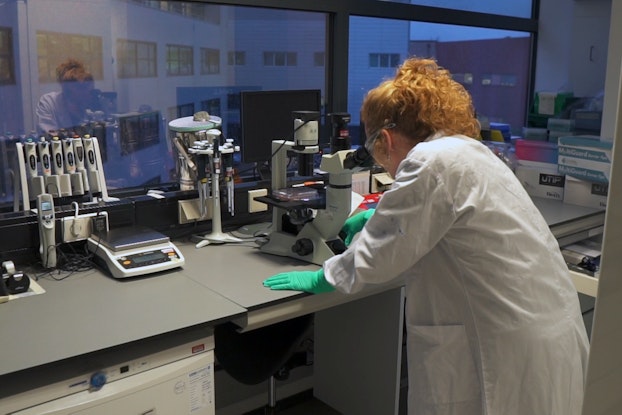
Why it matters:
- The pandemic has accelerated the digital transformation of B2B and B2C companies’ operations, from expediting research and development functions to streamlining supply chain processes.
- Many of these shifts are poised to stick after the crisis has passed, executives predict.
- At Johnson & Johnson, technology that created secure remote work environments, for example, proved critical to meeting pandemic-informed business objectives, CIO Jim Swanson said.
Healthcare products giant Johnson & Johnson has emerged as a key player in the global effort to vaccinate the world’s population against COVID-19, and technology has played an important role in its success, said Jim Swanson, chief information officer.
Its single-shot vaccine was recently approved for use in the U.S., and the company, whose consumer products division includes brands from Tylenol to Neutrogena, is working with rival drug maker Merck & Co. to produce 100 million doses for distribution in the U.S.
Speaking at a recent presentation during the CDX Accelerate conference attended by CO—, Swanson said Johnson & Johnson’s systematic approach to achieving business objectives, in which technology teams and business teams work in tandem to plan their strategies, served the company well.
The move comes as companies across industries expedited the digitization of their customer and supply-chain interactions — as well as their internal operations — by three to four years, according to a McKinsey report.
That digital transformation has been even more pronounced at healthcare companies, where the rate of tech change was nearly double that of CPG companies, the report found.
[Read here on pandemic business trends that are poised to stay.]

Pandemic speeds up timeline for producing results
Before the pandemic, Johnson & Johnson’s approach had been used to pursue objectives around areas such as omnichannel commerce and supply chain connectivity. To achieve these goals, the company created roadmaps detailing the technology developments that would be required to attain the desired outcomes.
“It wasn't, ‘This is the business strategy, and then here's the technology strategy, and hopefully they come together,’” Swanson said. “It was actually integrated. We took that same approach when COVID hit.”
The near-term goals, however, changed significantly, and the timeline for producing results accelerated rapidly. The pandemic-driven objectives suddenly incorporated new parameters around patient and employee safety, getting critical supplies to market, and maintaining connectivity with healthcare professionals and hospitals, which rely on Johnson & Johnson products for a range of needs, from pharmaceuticals to advanced medical devices used in surgeries.
The company found that its disparate teams across the organization all rallied around these and other common objectives, Swanson explained.
“We all aligned on ensuring we had supply. We all aligned on ensuring employees were safe. We all aligned on making sure we can keep connectivity with our healthcare professionals and the patients that we serve. And that drove our agenda,” he said.
Among the technologies Johnson & Johnson was able to leverage during the crisis was digital twinning, which allowed it to create computer simulations of supply chain processes, for example. This enabled the company to adjust various inputs in computer-generated models to optimize solutions.
What would have taken us probably months or years to test and pilot, we had to do in weeks.
Jim Swanson, chief information officer, Johnson & Johnson
J&J adjusts to — and learns from — virtual work models
Like many companies during the pandemic, Johnson & Johnson also had to adjust to the need for remote work environments, including video meetings, virtual sales calls and demand for cloud-based computing. The company had to transition its entire employee-support call center to off-site operations in a matter of days, for example.
[More here on managing a team in the remote-work era.]
The shift toward virtual models of conducting business yielded some unexpected benefits, however. By deploying tools such as webinars to replace in-person product training events for surgeons, for example, Johnson & Johnson found it could reach an even larger audience. Traditionally, attendance at such in-person events was often limited by the surgeons’ ability to travel, and other factors.
Instead, the events were able to attract much larger groups of participants from around the world, who were also able to communicate with each other online and share their own insights.
“That was something they really loved, and something that actually brought them more information that they needed to make sure that they get the right outcomes for their patients,” Swanson said.

In the healthcare industry, remote working and other virtual ways of doing business also present added challenges because of the importance of data security, Swanson explained. New security procedures and systems have to be implemented quickly.
“What would have taken us probably months or years to test and pilot, we had to do in weeks,” he said.
Agility and adaptability became critical skills, as the company was forced to continually act upon new insights and learnings that evolved day by day. The sharing of data is the “oil for the engine,” Swanson said, which allows the company to move quickly not only internally across silos but also with its business partners.
Making sure that the company’s data is “securely democratized across the enterprise,” he said, allows Johnson & Johnson “to accelerate innovations at a greater scale.”
Johnson & Johnson’s success leveraging technology during the pandemic has only raised the bar for further innovation, Swanson said.
“Technology is not more important than the science, and it’s not more important than the patients that we serve — they're always at the center of what we do,” he said. “But technology plays a critical role to deliver on our mission and purpose.”
-Barbara Thau contributed to this story.
CO— aims to bring you inspiration from leading respected experts. However, before making any business decision, you should consult a professional who can advise you based on your individual situation.
Follow us on Instagram for more expert tips & business owners stories.
CO—is committed to helping you start, run and grow your small business. Learn more about the benefits of small business membership in the U.S. Chamber of Commerce, here.








